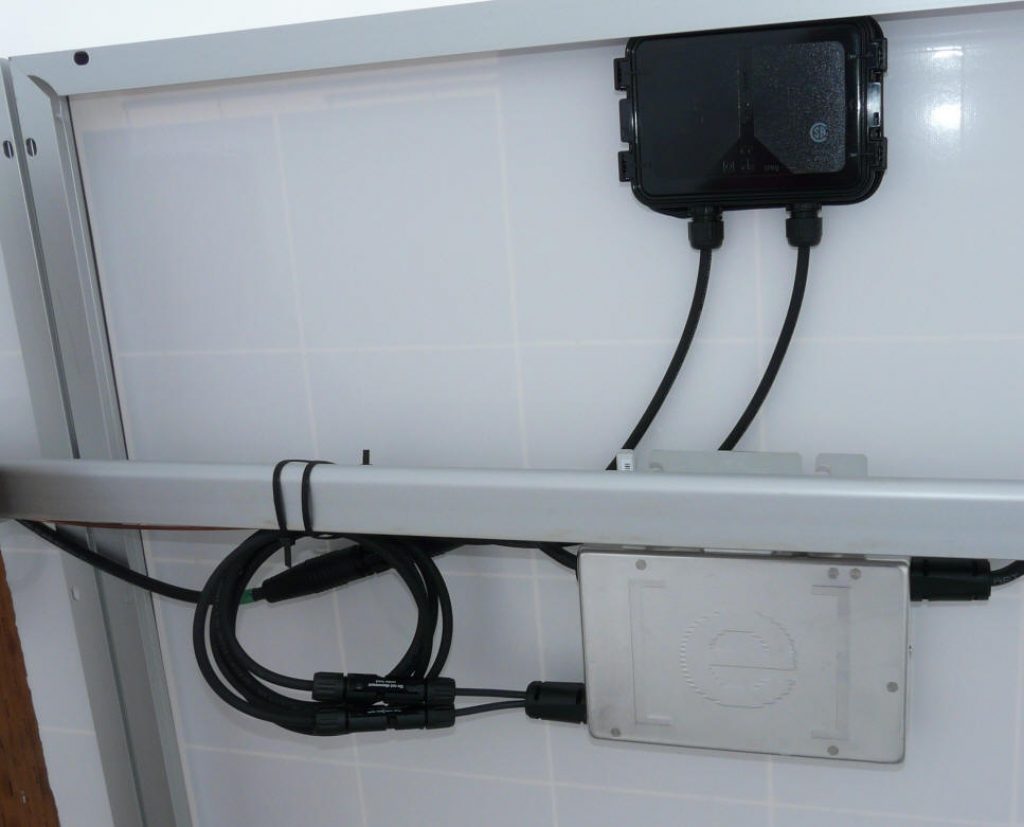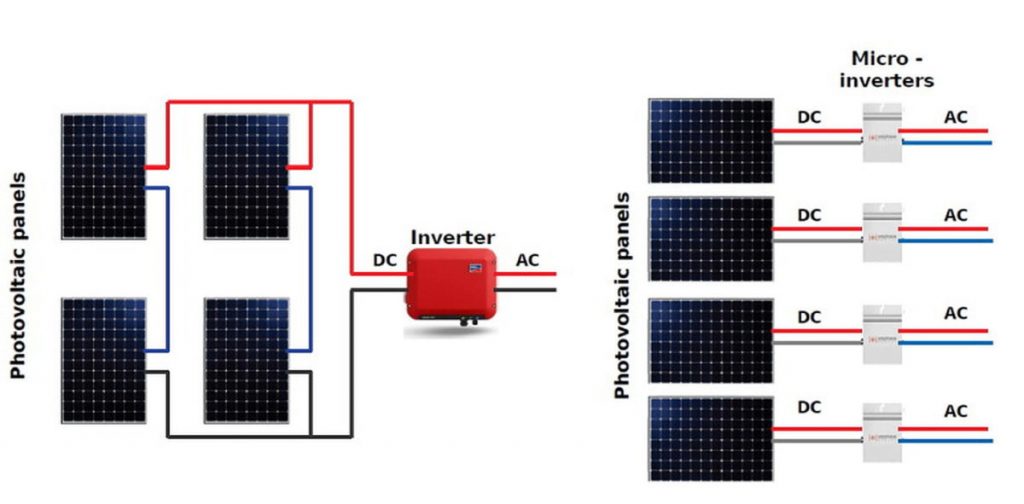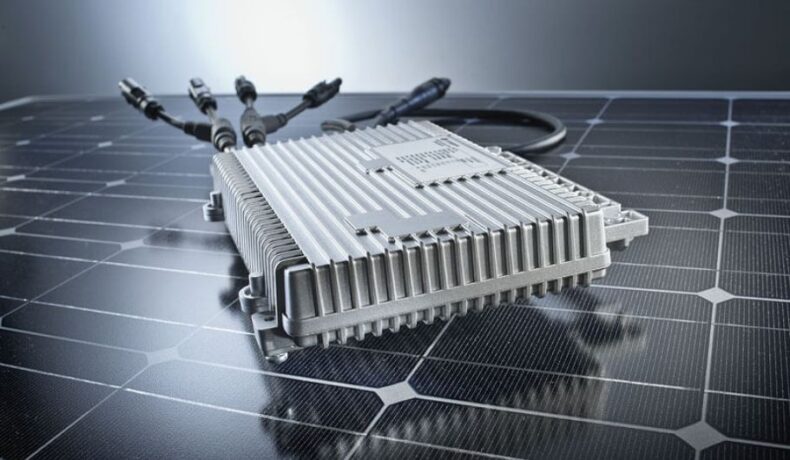Micro-inverters are referred to as MLPEs, which is the abbreviation for Module Level Power Electronics.
This all sounds very complicated but let’s have a look at what it all means.
Essentially solar panels are all about absorbing energy from the sun and converting that energy into electrical energy that we can utilize to power our electrical equipment.
In this article, we’ll describe the role of micro Inverters in producing electrical energy in conjunction with solar panels. We’ll also discuss what micro-Inverters are, what they do, and where to find them on a solar panel arrangement.
Table of Contents
What is a Micro-Inverter?
A micro-inverter, as the name suggests, is a small inverter. In fact, they are small enough that you can fit them to individual solar panels.
These tiny inverters, ranging in size between 200 – 250 Watts, transfer not only energy but data as well. The latter allows you to track the performance of your solar panels.
In many instances, manufacturers fit micro-inverters to the solar panel itself, which saves considerable on-site fitting time on DIY solar builds.
How Do Micro Inverters Work?
Micro-inverters contain a number of IGBT (Insulated Gate Bipolar Transistors). What these transistors do is very similar to a switch.
Imagine flicking two switches rapidly in a DC circuit. The switches are aligned so that the electrons flowing in the conductor are forced to change direction every time the switches are switched on and off. This would create AC electricity.
In this way, the inverter converts the DC voltage delivered from the solar panel into AC used in your electrical equipment.
When Would You Use A Micro-Inverter in Your Setup?
Inverters convert the DC power from your solar panel into AC power which you need to power your electrical appliances.
String inverters and micro-inverters do the same job, but like most things, both systems have pros and cons.
As we have seen, micro-inverters are generally dedicated to a single panel.
However, some micro-inverters can be used on two or four panels.
The fact that micro-inverters manage individual panels does provide a significant advantage. Especially if your solar panels suffer from shading or other issues that result in the substandard performance of individual panels.
In addition, issues like dirt and grime on some panels and panel orientation settings can significantly reduce output.

Advertisers of micro-inverters always refer to their products as “doing their best”. It conjures up images of little robots rushing about hurrying electrons along.
The reality though is that micro-inverters simply harvest all the available electricity from each solar panel independently.
While the quality of solar panels has soared, there remain subtle differences in the output of individual panels.
This may be the result of the panel’s orientation or other reasons, but the benefit of micro-inverters is that they can maximize the energy produced by each panel independently.
How Much Do Micro Inverters Cost On Average?
The fairest way to compare the relative cost of micro-inverters to string inverters is to look at the total cost of a standard domestic system.
Here we would be looking at a 5 kW solar system which would require 17 panels. Each with the potential of producing 300 Watts.
Theoretically, this would provide just over 5kW, but that is not important for our calculations. We simply want to know the number of panels required.
The average price of micro-inverters is a little misleading because there is a range of available features.
Prices start at around $90. They then increase according to features such as waterproofing, which shoots the price up to over $300. Then there are the versions with wireless remote controls, which seem to range in the higher $200 realm.
With an average price of around $250, this would indicate a total cost of just over $4,000 for a whole system.
As a general guide, the mico-inverter system will cost about 25 – 30% more to install than a string inverter.
Admittedly, this is significantly more than the comparable cost of a string inverter. However, in the next section, we’ll look at the advantages of a micro-inverter vs a string inverter.
Are Micro Inverters Worth The Extra Cost?
Dependability
Industry standards indicate that micro-inverters are far more reliable than their string counterparts.
Additionally, the warranties on micro-inverters stretch to over 20 years. Conversely, a string inverter may only enjoy protection for half of that period.
One of the significant advantages of a micro-inverter system is that of dependability. In saying that, inverters of either type are the weakest part of a system and are most likely to fail.
So when a string inverter system fails, that is the end of your solar-induced power. This is not the case with micro-inverters. If one micro-inverter should fail in your 5kW system it would represent a reduction of just less than 6% in the total output.
In all honesty, you may not even notice the reduction in power until you receive the notification from your system. Proponents of micro-inverters refer to this quality as ‘no single point of failure.’

Cabling
Another critical factor to consider is that of cabling.
For example, the direct current wiring of string inverters means that they are connected in series. Therefore, depending on the power output of the panels and the number of panels in the string, the total voltage may exceed the tolerances permitted by local authorities.
Take the example of a series of 12 panels, each producing 30 volts of DC.
The total voltage would exceed 300 volts. In order to get the total voltage, you add the voltage of each panel.
Now with micro-inverters, the circuit is connected in parallel. Because the micro-inverter converts the DC voltage of the solar panel to AC voltage at the panel, the result is a much better, controlled power supply.
In the latter case, the size of the wiring is much reduced, and there is no need to utilize a heavy-duty conduit. Having a lower voltage on the roof is an important safety feature.
Installing a micro-inverter system allows you to easily upgrade or extend your system, whereas a string inverter system does not. It’s not that it isn’t possible with a string system, the possibilities are just somewhat limited.
Cost
As systems increase in size, the cost difference between the micro-inverter system and the string inverter system tends to favor the latter, and systems above 6kW tend to rely on string inverters primarily because of cost.
Outcome
In short, while micro-inverters do come at a higher price than their string inverter cousins, their dependability and versatility make them worth it.
How Long Do Micro Inverters Last?
The short answer is, more than 20 years, but that doesn’t tell the whole story. Like many issues where the annoying answer is, ‘it depends.’ so to the lifespan of our micro-inverter.
So what factors influence the longevity of the micro-inverter?
For those of you living on the coast, you may be all too aware of the corrosive power of the sea air. Unfortunately, micro-inverters also succumb to the sea air.
Careful maintenance and regular cleaning will go some way to delay the inevitable but resign yourself to the fact that one day you will need to replace the inverters.
Other factors that may have a positive impact on the life cycle of the micro-inverter are the protection of the unit from excessive heat and direct sunlight.
As in most things, the quality and longevity of the micro-inverter are directly proportional.
Final Thoughts
The design and productivity of micro-inverters have improved dramatically in recent years, along with their reliability.
For typical households, a 5 – 6 kW solar system will provide sufficient energy.
While a string inverter will be less costly other factors such as shading or roof space and roof orientation may indicate that micro-inverters would be the better alternative.
If we had the choice, we would tend to favor the micro-inverter option as it can deal with irregularities in individual solar panels and, more importantly, allow for the easy extension of the entire system in the future.

